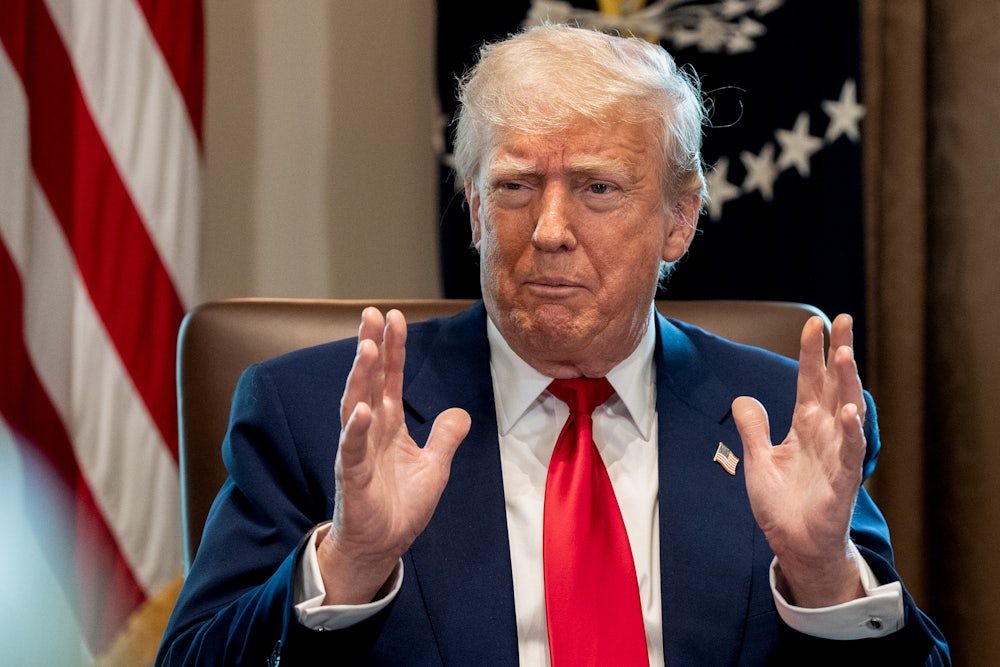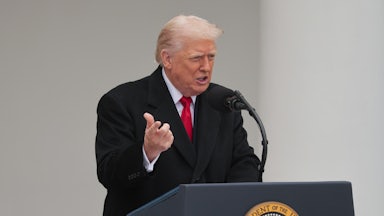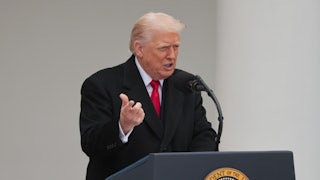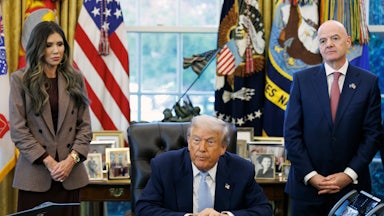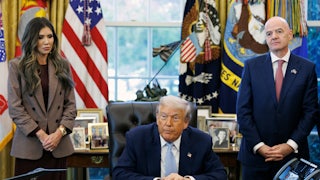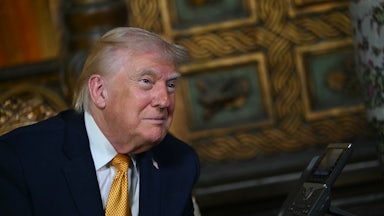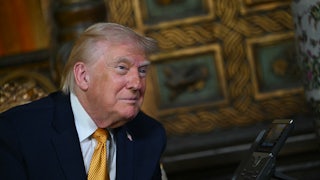President Trump is suddenly very taken with visions of Barbie doll factories in America. On three separate occasions, Trump has defended his tariffs by arguing that young American girls don’t need a lot of dolls—in fact, they can make do with fewer. His basic case, as top adviser Stephen Miller elaborated, is that we don’t need imported Chinese toys, because kids are already drowning in them, and most American parents will happily pay more for fewer quality dolls made in America rather than buy cheap and superfluous Chinese ones.
This has been widely analyzed from the consumer side of the equation. As many have noted, Trump—whose own kids were raised in literal golden splendor—is in no position to lecture Americans about accepting scarcity created by his own policies. Indeed, the whole conceit is a tacit admission that the tariffs will hike prices on consumers, which he keeps denying will occur.
But we should also look at Trump’s notion from the labor side. Even if Trump’s tariffs did spur a boom in domestic doll manufacturing, is that something we should want? As it turns out: not really. Many of the jobs this would create are bad ones. And even if it were possible for some fraction of manufacturing jobs along these lines to be decent ones, Trump’s own hostility to unions and government regulations would work against that goal.
Trump’s musings about young girls’ dolls are getting stranger. After floating the thought last week, Trump doubled down in a new interview with NBC News. “I don’t think a beautiful baby girl that’s 11 years old needs to have 30 dolls,” he said. “I think they can have three dolls or four dolls.”
“They don’t need to have 250 pencils,” Trump continued. “They can have five.” Wait, 11-year-olds are babies? And who wants 250 pencils, anyway?
Trump then reiterated the point to reporters on Air Force One, but this time, he grew angrier. “Let’s not waste a lot of time with stupid questions,” Trump ranted darkly, even though the queries posed concerned his own ideas about girls’ dolls, ones that raise obvious questions about the impact he himself expects his policies to have.
Miller’s explanation for all this has been that Americans will pay more for a “doll made in America” that has “higher quality” and a “higher environmental and regulatory standard” than for a Chinese model with “lead paint” that’s “not as well constructed.” Watch, via Aaron Rupar:
Stephen Miller: "If you had a choice between a doll from China that might have lead paint from it that is not as well constructed, as a doll made in America that has a highly environmental and regulatory standard ... and those two products are both on Amazon, that yes, you… pic.twitter.com/HfisWdbJ0b
— Aaron Rupar (@atrupar) May 1, 2025
Let’s say Trump and Miller did succeed in ensuring that a lot more dolls get manufactured in the United States. What would we get out of that?
Well, the biggest-selling dolls and doll accessories, as of September 2024, were various Barbie products, Monster High dolls, Baby Alive dolls, and Disney Princess products, according to The Toy Book, a trade publication. Those are almost exclusively manufactured by Mattel, with one made by Hasbro. Both companies manufacture large percentages of imported toys in China and other East Asian countries.
It’s not easy to track down information on the working conditions in such factories, as some of this manufacturing is outsourced to subcontractors and much of it is done “across multiple countries,” says James Zahn, editor of The Toy Book. But people who work in toy manufacturing will tell you that in general, making dolls like these inevitably involves human-performed tasks that aren’t typically seen as good jobs.
One is the molding of dolls’ arms, legs, and other body parts. According to Jonathan Cathey, the CEO of the Loyal Subjects, a California-based toy company that manufactures products abroad, this is typically done with molding machines, with a human worker usually needed to detach finished plastic parts from plastic model-like trees.
Meanwhile, creating dolls’ faces and attaching their hair often requires connecting the head by hand to different machines, after which lips and eyes are stenciled on and the hair (often made of nylon) is grafted to the scalp. Still another chore often done by hand is attaching arms and legs to torsos. Yet another involves the creation of dolls’ miniature clothes at sewing machines.
“You’re sitting on a line, assembling things, like Laverne and Shirley putting bottle caps on bottles,” Cathey tells me, referring to the old TV series. “Do most Americans want to sew tiny little skirts a thousand times a day?”
With some fashion dolls, parts of the faces are even hand-painted, says Jay Foreman, founder and CEO of Basic Fun, a Florida-based toy company that also makes products abroad. “These are all individual tasks that require an operator to perform each of them,” Foreman tells me. “The manufacturing process is incredibly laborious.”
There’s no easy way to envision mass domestic doll manufacturing creating lots of good jobs, these people tell me. It’s not just that much of the human-performed work is drudgery. There are also other factors, they say: Lots of the materials you’d need to make the dolls, as well as many of the machines for making them, are also manufactured abroad. So you’d need to import all that anyway.
“With most doll production, you’re going to be sourcing raw materials from a global supply chain, including nylon for the hair and plastic for the doll body,” Zahn tells me.
Even if we could construct a massive and largely domestic supply chain for dolls, it would take many years to spin up. And it’s not clear how long many of the manufacturing jobs would last, even if we did do that. “The only thing that will happen is eventually robots and AI will take over,” Cathey says.
What about the fundamental trade-off that Trump and Miller posit, in which we exchange 30 Chinese dolls for three American ones of higher quality, accepting far fewer things in exchange for quality ones?
None of this adds up, either. Even if you think some good outcomes might result from producing far fewer plastic toys, lots of quality jobs won’t be one of them. Indeed, the opposite would happen, these industry officials tell me: Because toy companies also employ lots of higher-end professions like design and marketing—and these are the jobs that are concentrated in the United States already—producing far fewer toys would kill many of those good American jobs, while creating far fewer bad manufacturing jobs in their place.
“You’d be trading millions of good-paying jobs for tens of thousands of horrible-paying jobs,” Cathey says.
There’s still more. If the stated goal of tariffs is to create durable, high-quality American jobs, weakening unions and gutting regulatory oversight—which the Trump administration is fully committed to doing—is a recipe for further undermining that goal. This is particularly true of something like the toy industry, with its focus on high-volume, repetitive tasks involving all manner of synthetic materials.
Josh Bivens, chief economist at the Economic Policy Institute, points out that Trump has laid off large numbers of officials at agencies overseeing worker safety, halted government rules ensuring good working conditions, and fired pro-worker, pro-union appointees at the National Labor Relations Board, among many other things.
“What makes manufacturing jobs good is unions and regulations that protect worker safety,” Bivens told me. “Without those things, any jobs created by somehow bringing toy manufacturing back are not going to be good or safe jobs.”
As Paul Krugman details, many Trump officials are now explicitly packaging the idea of a revival of low-level manufacturing work in many areas—from sneakers to apparel—in the language of nostalgia for the 1950s. It’s a preposterous notion, one that gets at the core absurdities and outright lies embedded in MAGA ideology at a very fundamental level.
After all, the whole selling point behind the promise of restored manufacturing is supposed to be that this will create a lot of good breadwinner jobs that will then shore up stable, virtuous manufacturing communities. But trying to reshore things like doll manufacturing—while rolling back worker protections and the regulatory state, which is also a core ideological commitment of Trumpism—is a recipe for anything but. The brutal, poorly paid factory work that would result is not what Trumpism, in its romanticized and idealized forms, is supposed to be offering.
Yet that would very much be the reality. “Painting eyeballs on Barbie dolls and styling the hair of Bratz dolls,” notes Foreman drily, “aren’t the kinds of jobs that President Trump has promised in Michigan or Alabama.”
